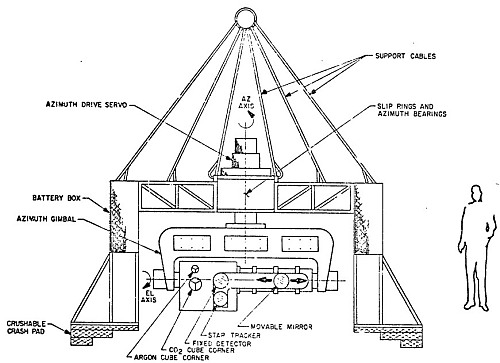Purpose of the flight and payload description
The BAPE experiment were a series of balloon flights aimed to investigate the propagation of laser beams from the ground level to 28 km. A ground-based laser tracking system developed by NASA/GSFC projected Argon and CO2 laser beams toward a balloon-borne optical receiver system.
The balloon-borne receiver system included two argon receivers and two HgCdTe CO2 receivers. A laser tracker and servosystem kept the receivers and a 1 inch diameter retroreflector pointed towards the ground station during data collection periods.
Separation of the argon and CO2 detectors was varied from 2 to 82 cm. Data from each receiver channel was telemetered to the ground station and recorded. Ambient pressure and temperature, azimuth and elevation bearings, tracking error signals, and other experiment control data were also telemetered to the ground station. The balloon-borne instrumentation and the complete telemetry system was developed by GTE Sylvania.
Details of the balloon flight
Balloon launched on: 10/21/1970 at 00:15 mst
Launch site: Upham, New Mexico, US
Balloon launched by: HOLLOMAN
Balloon manufacturer/size/composition: Zero Pressure Balloon 20.000.000 cuft
Flight identification number: H70-63
End of flight (L for landing time, W for last contact, otherwise termination time): 10/21/1970 at 8:30 mst
Balloon flight duration (F: time at float only, otherwise total flight time in d:days / h:hours or m:minutes - ): ~ 8 h
Landing site: Near Roswell, New Mexico, US
Payload weight: 1750 lbs
The balloon system was launched from Upham, New Mexico, at 12:15 A.M. MST, October 21, 1970. Data was taken from 5:37 to 7:59 A.M. during which time the altitude and slant range varied from 26 to 28 km and 30 to 40 km, respectively.
External references
- Balloon atmospheric propagation experiment I (BAPE I) IEEE Journal of Quantum Electronics, vol. 7, issue 6, pp. 273-274
- Results of the Balloon Atmospheric Propagation Experiment Flights of 1970 (Bape 1) NASA Technical Report, 1972
7877If you consider this website interesting or useful, you can help me to keep it up and running with a small donation to cover the operational costs. Just the equivalent of the price of a cup of coffee helps a lot.


